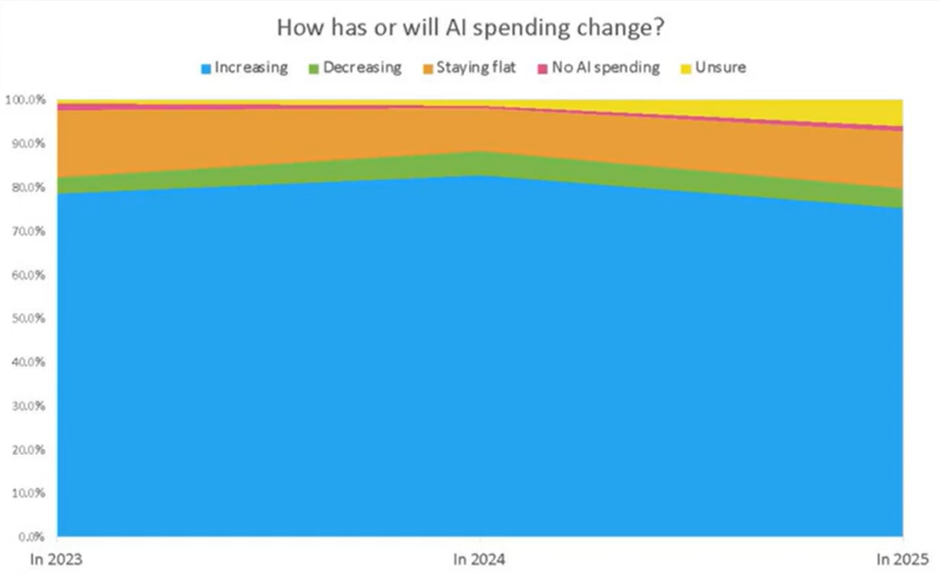The adoption of AI across the contact center space is rapidly accelerating.
New research from Metrigy spotlights this trend, with over 70 percent of contact centers increasing their AI spending in 2023 and 2024.
Don’t expect any U-turns in 2025, either, as the graphic below showcases.

Indeed, it seems that most contact center leaders have their feet on the AI throttle.
During a recent CX Today webinar, Robin Gareiss, CEO & Principal Analyst at Metrigy, highlighted the primary driver of this trend. She said:
“The number one reason: AI brings efficiencies. So, contact centers are seeing it, they’re measuring it, and they’re experiencing it.”
Yet, while driving efficiency may top the list, there are many more reasons why contact centers are pumping funds into AI.
What’s Driving the Surging Investment In Contact Center AI?
Metrigy unpacked five principal drivers for heightened investment in contact center AI in its study.
As noted, unlocking new efficiencies came out on top. But behind that, Metrigy found implementing AI to “improve CSAT” and “increase revenues” to be the second and third primary drivers, respectively.
Interestingly, the analyst found that competitive pressure – and the feeling of not getting left behind – is the fourth most prominent motive.
That worryingly suggests that lots of leaders feel pushed into adopting AI, which may prove risky. After all, many may jump to implement ill-fitting use cases, bloat the CX stack, and fail to achieve all the possible benefits of AI.
Finally, reducing attrition came in as the fifth driver, which is unsurprising given the decades-long tussle that contact centers have had with reducing agent churn.
Thankfully, contact centers are reporting that AI is helping to meet many of these objectives, according to Gareiss. She summarized:
“We see that companies are transforming. They’re spending more, and they’re using a lot of different technologies with real clear results.”
To drive those results, Metrigy identified eight “top” areas of spending increases in contact center AI, as explored below.
Where Are Contact Centers Investing In AI?
According to Metrigy, the top areas for spending increases in contact center AI are:
- AI for employee collaboration
- Identity verification
- Customer self-service bots
- Contact center workforce engagement management (WEM)
- Triage bots
- Agent-Assist
- Employee self-service bots
- Voice of the Customer (VoC) programs
The top two may come as a surprise, especially as the noise around other AI-led technologies – including virtual agents and assistants – reaches a fever pitch.
However, as the “new normal” has finally become “normal”, contact centers are fine-tuning their hybrid and remote environments.
Ensuring they have AI-infused apps supporting collaboration around complex customer cases – perhaps as part of a unified UC-CC platform – is critical to support swift resolutions, contact center efficiency, and agent well-being.
Meanwhile, identity verification has likely surged to the top of the agenda as businesses recognize new security threats, such as generative AI (GenAI)- powered deepfakes.
Lastly, consider the third and fourth “top areas”: customer self-service bots and contact center WEM. The advent of GenAI has significantly boosted these arenas.
While concerns remain over autonomous GenAI bots responding to questions without a human-in-the-loop – its role in auto-generating bot flows, lexicons, and test data is helping to reimagine the conventional self-service bot building process.
In terms of WEM, GenAI has made use cases – such as auto-QA and sentiment analysis – a standard feature within leading CCaaS platforms. Previously, only specialized vendors could do that.
That perhaps exemplifies a final driver of increased AI investment: increased accessibility.
New-wave CCaaS vendors can now offer capabilities out-of-the-box and at a lower price point than many stalwarts, which previously spent hundreds of hours engineering similar tools. To a large extent, large language models (LLMs) have made all of that hard work obsolete.
Using AI to Bolster Customer, Employee, & Business Outcomes
While the AI deployments of other organizations may spark the imagination of service leaders, every contact center has unique challenges that it will try to mitigate with AI.
There are several ways to do that, from embracing intent-level journey orchestration to addressing a targeted list of problem statements.
However, most crucially, Michelle Couture, Global Lead of CX Product Marketing at Zoom, stresses the importance of closely considering the impact of AI decisions and deployments on the contact center’s three critical stakeholders: customers, agents, and the broader business.
In addition, Couture noted that Zoom is closely considering the implications of its AI across these three stakeholders to build confidence amongst its customer base.
Speaking during the CX Today webinar, she stated:
“We’re thinking about AI in these three buckets. How are we exceeding customer expectations, empowering agents, and making sure the business has the insight it needs?”
From there, Couture introduced how Zoom has infused AI across all of its CCaaS packages, allowing customers to pick and choose the best use cases for their specific requirements.
For more on Zoom’s AI approach and CCaaS bundling strategy, visit: www.zoom.com/en/products/contact-center/







